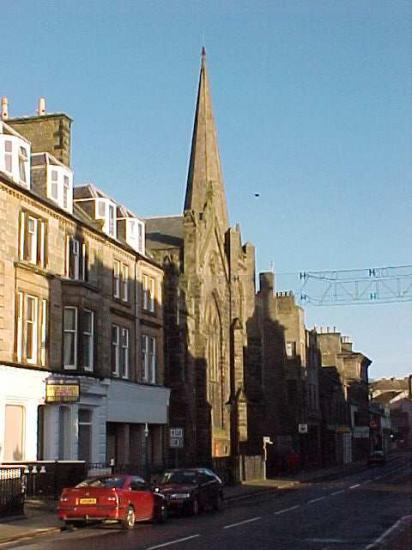Bridge Street Church, Wick To Become Furniture Store
3rd March 2015

After many years of speculation about what would happen the the former Church of Scotland church at Bridge Street, Wick it has finally been given a new lease of life.
Planning permission has been granted by Highland council to Mr Graeme Bain of Wickblast to change the use to a furniture store. Permission has been granted for works to be carried out both inside and outside of the building.
The church was opened in 1843 and close in 2009.
On Saturday, 22 March 2009 hundreds visited Wick's beautifully decorated Bridge Street Church on the final Open Day to browse amongst the photographs and other memorabilia and to watch Alan Sinclair's presentation of the history of the Church. One hundred and sixty six years after the Disruption, and proposed by Church of Scotland Headquarters as far back as 1941, Wick Old Parish and Wick Bridge Street churches will finally be re-united. The service of Union, which is open to all, will take place in the renamed Wick St Fergus Church on Friday 3rd April at 7.30pm.
In his booklet published in 1999 the Reverend A. A. Roy - who retired in 2007 as the last and, having spent 52 years in Wick, the longest serving of the church's eleven Ministers - provides an interesting history of what is currently known as Wick Bridge Street Church of Scotland, its first Minister having been the Reverend Charles Thomson.
The Disruption of 1843 led to the formation of the Free Church of Scotland whose Ministers were elected by their congregations (rather than chosen for them by patrons such as local landowners) and financed through the voluntary contributions of the church members and adherents. In Wick the Reverend Thompson, whose portrait hangs in Bridge Street Church, left the Established Church (currently known as Wick Old Parish) taking the majority of his congregation with him and they worshipped in the open air at the Glebe Park until their new building, known as Wick Free Church, was built on the site now occupied by the Somerfield supermarket. In 1862 plans for the present building in Bridge Street were drawn up and it took three years to build the impressive neo-Gothic style building which has seating for over a thousand and which cost well over £1,000. Records show that the money was raised by the congregation, many giving substantial donations to pay for the new Wick Free Church. Later renamed Wick United Free Church following the union between the Free Church of Scotland and the United Presbyterian Church of Scotland in 1900, it finally became known as Wick Bridge Street Church of Scotland in 1929 after the unification of the Established Church and the United Free Church.
Bridge Street congregation has always displayed such generosity and, over the years, many have given of their time and money. A great debt of gratitude is owed in particular to the Elders, Deacons and Board Members, the choirs and organists who enhanced the weekly services, those who ran the church organisations such as the Sunday Schools in both Bridge Street and the Barrogil Hall and the Youth Groups, Fellowships and Guilds, and also to those who arranged flowers, distributed envelopes, baked, cleaned and effected repairs to the building.
Due to the success of the Church, and the large attendances, its ministry expanded into Pulteneytown when the congregation acquired the Barrogil Hall in the early eighteen nineties, and later, in 1903, the Zion Hall in Victoria Place, which was used until 1918 when it was sold to the Salvation Army. Previously, in 1862 the first Free Church building which was then only 22 years old, was purchased by the Gaelic Committee for worship by the large numbers who arrived annually from the west of Scotland for the herring fishing season.
During its history - in addition to Sunday Schools, Bible Class, Women's Guild, the Church Choir and Sunday School choirs, Young Mothers' Group, Young Men's Christian Association, Ladies Work Party, the Christian Endeavour and the Youth Fellowship - Wick Bridge St Church has also been home to a Literary Society, the Girls Guildry, a Girl Guide Company, Wick Youth Club and one organization which drew crowds too large even for a church of this size. This was the "Brotherhood" whose monthly open meetings were sometimes so well attended that people sat in the aisles and even on the the pulpit steps. The banner of The Brotherhood, designed by the wife of the Reverend Alfred Coutts who ministered between 1909 and 1912, has recently been gifted to Wick Heritage Centre.
Nearly a hundred years on from those days, while the congregations of both Bridge Street and the Parish churches have over the years managed through the generosity and hard work of their congregations to remain self-supporting, the dwindling numbers attending church and the dearth of Ministers has led to the situation whereby the Church of Scotland will not allow Wick Bridge Street and Wick Old Parish to remain independent of each other. In 2002 Caithness Presbytery Working Group decided that in order to cope with this shortage of Ministers, a linkage and ultimate Union of the Wick Old Parish and Wick Bridge Street churches would be necessary. The linkage took place on the retirement of Reverend A. Roy in July 2007 and the Union was then to follow within two years.


